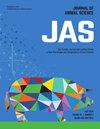Restricted versus ad libitum Feeding during Sow Gestation Affects Piglet Performance, Behavior, and Fecal Microbiota Composition.
IF 2.7
2区 农林科学
Q1 AGRICULTURE, DAIRY & ANIMAL SCIENCE
引用次数: 0
Abstract
This study investigated how the nutrition of gestating sows affects piglet performance, behavior, and fecal microbiota. Twenty-four sows were divided into two feeding groups: those on a restricted diet (once a day) and those fed ad libitum (as much as they wanted), with all receiving the same diet during lactation. The piglets were categorized based on their feeding groups; RG-RL: Piglets born and nursed by restricted-fed sows with restricted feeding, AG-AL: Piglets born and nursed by ad lib-fed sows, RG-AL: Piglets born by restricted-fed sows and nursed by ad lib-fed sows, and AG-RL: Piglets born by ad lib-fed sows and nursed by restricted-fed sows. Performance traits were analyzed using the model including treatment, switching piglets, and room effects. Piglet behavior was evaluated with a generalized linear mixed model (GLMM) using binomial distribution, testing interactions of treatment, switching, gender, and other factors while accounting for random effects related to room, pen, and sow. Results showed that ad lib-fed sows had higher feed intake (P < 0.001), weight gain (P = 0.04), and backfat gain (P = 0.01) compared to restricted-fed sows. They also had lower cortisol levels during gestation (P = 0.02) and lactation (P = 0.04). Restricted-fed sows displayed more air-chewing behavior (P = 0.002), while ad lib-fed sows were more active (P = 0.03) and engaged in eating (P < 0.001). Birth weights and the number of piglets were similar across groups. During lactation, backfat loss varied among piglet groups, with the highest loss in AG-RL (P < 0.01). Piglets from ad lib-fed sows performed better overall, regardless of nursing source. At weaning, piglet weights (P = 0.01) were highest in AG-AL, followed by RG-AL, RG-RL, and AG-RL (interaction effect P = 0.006). Switching piglets initially reduced their playtime but later increased it (P = 0.04). The novel object test indicated that gilts became more active, resembling boars. Additionally, gut microbiota composition varied among sow groups during gestation (P = 0.04) and lactation (P = 0.02), suggesting that maternal diet influences piglet gut health. Overall, these findings highlight the potential role of epigenetic mechanisms in shaping these traits.母猪妊娠期限制饲喂与自由饲喂对仔猪生产性能、行为和粪便微生物群组成的影响。
本研究探讨了妊娠母猪营养对仔猪生产性能、行为和粪便微生物群的影响。24头母猪被分为两个喂养组:限制饮食组(每天一次)和自由饮食组(想吃多少就吃多少),所有母猪在哺乳期间都吃同样的饮食。仔猪按饲喂组进行分类;RG-RL:限饲母猪出生和哺育的仔猪,AG-AL:自由饲养母猪出生和哺育的仔猪,RG-AL:自由饲养母猪出生和哺育的仔猪,AG-RL:自由饲养母猪出生和哺育的仔猪。采用处理、转群仔猪和房间效应模型分析生产性能。采用二项分布的广义线性混合模型(GLMM)评估仔猪行为,测试处理、切换、性别和其他因素的相互作用,同时考虑与房间、猪圈和母猪相关的随机效应。结果表明:自由饲喂母猪采食量(P < 0.001)、增重(P = 0.04)和背膘增重(P = 0.01)均高于限制饲喂母猪。她们在妊娠期(P = 0.02)和哺乳期(P = 0.04)皮质醇水平也较低。限制饲养母猪表现出更多的空气咀嚼行为(P = 0.002),自由饲养母猪表现出更多的活动(P = 0.03)和进食行为(P < 0.001)。各组仔猪初生重和仔猪数相近。哺乳期间,各组仔猪背脂损失差异显著,AG-RL损失最高(P < 0.01)。无论奶源如何,自由饲喂母猪的仔猪总体表现更好。断奶仔猪体重以AG-AL组最高(P = 0.01),其次为RG-AL组、RG-RL组和AG-RL组(互作效应P = 0.006)。转换仔猪的玩耍时间最初减少,但随后增加(P = 0.04)。新对象测试表明,后备母猪变得更加活跃,类似于公猪。此外,妊娠期(P = 0.04)和哺乳期(P = 0.02)母猪组间肠道菌群组成存在差异,表明母体饲粮影响仔猪肠道健康。总的来说,这些发现强调了表观遗传机制在塑造这些特征中的潜在作用。
本文章由计算机程序翻译,如有差异,请以英文原文为准。
求助全文
约1分钟内获得全文
求助全文
来源期刊

Journal of animal science
农林科学-奶制品与动物科学
CiteScore
4.80
自引率
12.10%
发文量
1589
审稿时长
3 months
期刊介绍:
The Journal of Animal Science (JAS) is the premier journal for animal science and serves as the leading source of new knowledge and perspective in this area. JAS publishes more than 500 fully reviewed research articles, invited reviews, technical notes, and letters to the editor each year.
Articles published in JAS encompass a broad range of research topics in animal production and fundamental aspects of genetics, nutrition, physiology, and preparation and utilization of animal products. Articles typically report research with beef cattle, companion animals, goats, horses, pigs, and sheep; however, studies involving other farm animals, aquatic and wildlife species, and laboratory animal species that address fundamental questions related to livestock and companion animal biology will be considered for publication.
 求助内容:
求助内容: 应助结果提醒方式:
应助结果提醒方式:


